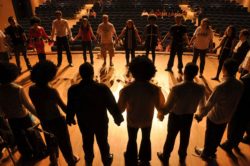About
How do people of conflicting worldviews, memories and future visions encounter each other?

ETHER (Ethics and Aesthetics of Encountering the Other), an international AHRC research network, is a research partnership of the University of Leeds, the University of Stirling, Opera North, and Leeds Museums and Galleries. ETHER asks: 'How do people of conflicting worldviews, memories and future visions encounter each other?' It brings together international artists, linguists, philosophers, cultural organisations and educators to examine aesthetic and ethical dimensions of communal meaning making across geographical boundaries and domains of social life: in music and dance rehearsal rooms, in museums and art galleries, in theatres, markets, service encounters, schools. We study existing research and experiential evidence of these interactions and examine what genuine encounters with difference look like and what it takes to enable them. The resulting theoretical and methodological frameworks will advance inquiry across academic disciplines and creative practices. The practical guidelines will support public institutions in the UK and internationally in their commitment not only to reach diverse communities but to become catalysts for genuine encounters across divides of any kind.
Theoretical and methodological orientation
To examine what this kind of engagement looks like and what it takes to enable it, our inquiry starts with an anthropological orientation. It assumes that the key question of this network, “How do people of conflicting worldviews, memories and future visions encounter each other?”, must be explored in relation to the fine detail of lived life (Geertz, 2000; MacIntyre, 2013). Such an attention to detail is made possible through the art’s capability to look, see, listen and hear (Illingworth, 2017), linguistics’ ability to make visible ritual encounters of civility (Blackledge & Creese, 2018) and acts of meaning making with the other (Kubanyiova, 2019; Kubanyiova & Yue, 2019) and with philosophy’s capacity to flesh out the “thick”, the particular and the culturally integrated development of people’s moral acts of turning towards the other (Flanagan, 2017; Malik, 2014; Waltzer, 1994).
To advance ETHER's question, we will examine the contribution of aesthetic experience to knowledge in general and to growing human capacity to receive the other (Biesta, 2015) in particular. Conceptualized as a combination of distinctive multimodal forms of knowledge, an emotional experience, and an exercise of the imagination (Guyer, 2014), aesthetic engagement is central to the content, mode and intended outcomes of our inquiry. ETHER seeks to make connections between linguistic, oral, visual and performative modes of inquiry and cultural expression that are typically isolated from one another in research, but which promise to shed significant new light on the key question of this research network.
Why ETHER
Cultural, civic and educational organisations are expected to create a platform for such encounters and their public value is increasingly assessed on how well they reflect societal diversity in their core activity, outreach and governance. While some improvement on diversity measures, such as gender, age, ethnicity or disability, is evident within these sectors, less is known on what meaningful engagement across and within these categories looks like, why and how it matters and what it takes to foster it.
Diversity is not the melting-pot, the pulp, the mish-mash, etc. Diversity is differences that encounter each other, adjust to each other, oppose each other, agree with each other and produce the unpredictable (Glissant, 1996, p. 98).
This is an urgent question in the face of disconcerting societal tendencies around the world: the coarsening of public discourse in increasingly divided societies, the rise of political and military activism fuelled by hostility and violence towards the other, or the fast-spreading epidemic of loneliness and mental illness across and within generations and social strata. This international AHRC research network is based on the recognition that genuine engagement with difference of any kind is necessary for building peaceful, sustainable and healthy communities. It also acknowledges, however, that success on diversity measures alone does not guarantee meaningful encounters with those who are not like ‘us’. Such engagement requires effort, can be difficult to bring about, and sharing the same space is a necessary but insufficient condition for it to occur.
What is the preliminary condition for this entire process, this equation? It is the will to become acquainted, the desire, the act of turning towards the Other…However, in actual practice it turns out to be extremely difficult. Human experience shows that at the first moment, as a first reflex a person reacts to an Other with reserve …or even with hostility (Kapuściński, 2009, p. 73).
ETHER addresses this challenge by shifting the theoretical focus from diversity as a social category to difference as a quality that defines every human being. This shift implies that human interactions of any kind are meetings with difference. They are not made meaningful by emphasising sameness, but by exercising an ethical commitment to preserving difference while making a genuine contact. How individuals and communities practise this encounter with ‘the other’ across diverse contexts of human activity can have profound consequences for addressing some of the global societal conflicts.
